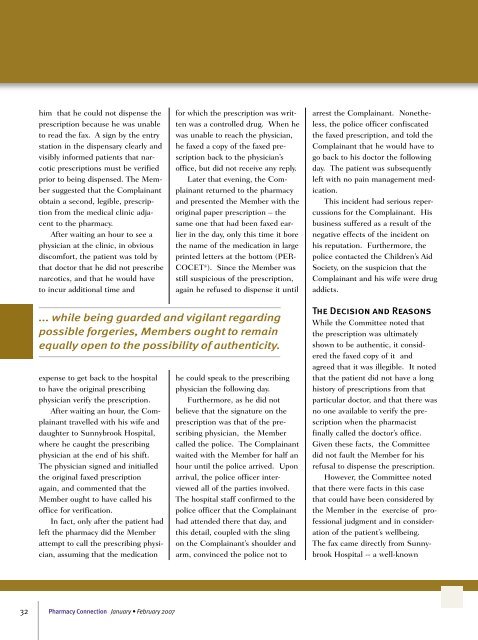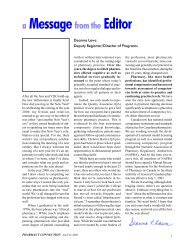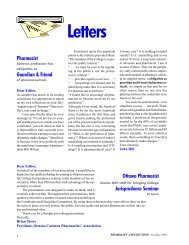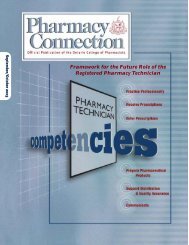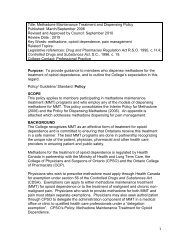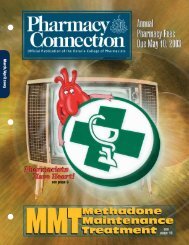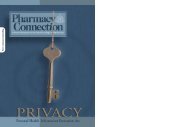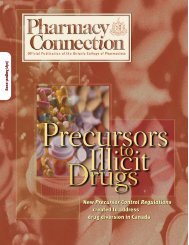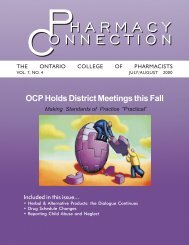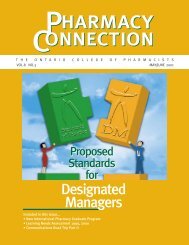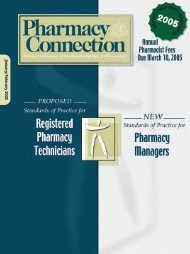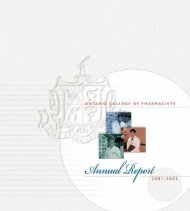INSIDE: - Ontario College of Pharmacists
INSIDE: - Ontario College of Pharmacists
INSIDE: - Ontario College of Pharmacists
You also want an ePaper? Increase the reach of your titles
YUMPU automatically turns print PDFs into web optimized ePapers that Google loves.
him that he could not dispense the<br />
prescription because he was unable<br />
to read the fax. A sign by the entry<br />
station in the dispensary clearly and<br />
visibly informed patients that narcotic<br />
prescriptions must be verified<br />
prior to being dispensed. The Member<br />
suggested that the Complainant<br />
obtain a second, legible, prescription<br />
from the medical clinic adjacent<br />
to the pharmacy.<br />
After waiting an hour to see a<br />
physician at the clinic, in obvious<br />
discomfort, the patient was told by<br />
that doctor that he did not prescribe<br />
narcotics, and that he would have<br />
to incur additional time and<br />
for which the prescription was written<br />
was a controlled drug. When he<br />
was unable to reach the physician,<br />
he faxed a copy <strong>of</strong> the faxed prescription<br />
back to the physician’s<br />
<strong>of</strong>fice, but did not receive any reply.<br />
Later that evening, the Complainant<br />
returned to the pharmacy<br />
and presented the Member with the<br />
original paper prescription – the<br />
same one that had been faxed earlier<br />
in the day, only this time it bore<br />
the name <strong>of</strong> the medication in large<br />
printed letters at the bottom (PER-<br />
COCET ® ). Since the Member was<br />
still suspicious <strong>of</strong> the prescription,<br />
again he refused to dispense it until<br />
arrest the Complainant. Nonetheless,<br />
the police <strong>of</strong>ficer confiscated<br />
the faxed prescription, and told the<br />
Complainant that he would have to<br />
go back to his doctor the following<br />
day. The patient was subsequently<br />
left with no pain management medication.<br />
This incident had serious repercussions<br />
for the Complainant. His<br />
business suffered as a result <strong>of</strong> the<br />
negative effects <strong>of</strong> the incident on<br />
his reputation. Furthermore, the<br />
police contacted the Children’s Aid<br />
Society, on the suspicion that the<br />
Complainant and his wife were drug<br />
addicts.<br />
... while being guarded and vigilant regarding<br />
possible forgeries, Members ought to remain<br />
equally open to the possibility <strong>of</strong> authenticity.<br />
expense to get back to the hospital<br />
to have the original prescribing<br />
physician verify the prescription.<br />
After waiting an hour, the Complainant<br />
travelled with his wife and<br />
daughter to Sunnybrook Hospital,<br />
where he caught the prescribing<br />
physician at the end <strong>of</strong> his shift.<br />
The physician signed and initialled<br />
the original faxed prescription<br />
again, and commented that the<br />
Member ought to have called his<br />
<strong>of</strong>fice for verification.<br />
In fact, only after the patient had<br />
left the pharmacy did the Member<br />
attempt to call the prescribing physician,<br />
assuming that the medication<br />
he could speak to the prescribing<br />
physician the following day.<br />
Furthermore, as he did not<br />
believe that the signature on the<br />
prescription was that <strong>of</strong> the prescribing<br />
physician, the Member<br />
called the police. The Complainant<br />
waited with the Member for half an<br />
hour until the police arrived. Upon<br />
arrival, the police <strong>of</strong>ficer interviewed<br />
all <strong>of</strong> the parties involved.<br />
The hospital staff confirmed to the<br />
police <strong>of</strong>ficer that the Complainant<br />
had attended there that day, and<br />
this detail, coupled with the sling<br />
on the Complainant’s shoulder and<br />
arm, convinced the police not to<br />
The Decision and Reasons<br />
While the Committee noted that<br />
the prescription was ultimately<br />
shown to be authentic, it considered<br />
the faxed copy <strong>of</strong> it and<br />
agreed that it was illegible. It noted<br />
that the patient did not have a long<br />
history <strong>of</strong> prescriptions from that<br />
particular doctor, and that there was<br />
no one available to verify the prescription<br />
when the pharmacist<br />
finally called the doctor’s <strong>of</strong>fice.<br />
Given these facts, the Committee<br />
did not fault the Member for his<br />
refusal to dispense the prescription.<br />
However, the Committee noted<br />
that there were facts in this case<br />
that could have been considered by<br />
the Member in the exercise <strong>of</strong> pr<strong>of</strong>essional<br />
judgment and in consideration<br />
<strong>of</strong> the patient’s wellbeing.<br />
The fax came directly from Sunnybrook<br />
Hospital -- a well-known<br />
32<br />
Pharmacy Connection January • February 2007


